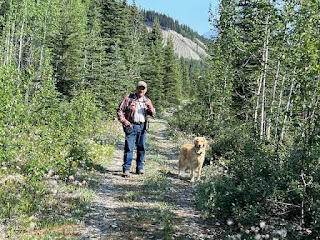Warning: Waxing Rhapsodic (yet again)
We love being on the road and able to travel like we do. Many have asked how we do this for so long a time. We don’t want to give you the idea that it’s total bliss. Some days, it is no panacea. Driving long days from Texas to the Arctic can be exhausting. It takes planning to live three to four months without a refrigerator and only having a backpacking stove and mess kit as a kitchen. Being 18-inches apart from the one you love for three months can sometimes be a challenge. And traveling with a young pup definitely makes it more interesting.
Bugs can be really terrible up here. Alaskans call the mosquito their state bird. These mosquitoes are huge… and they definitely drink blood. Caribou can lose as much as a quart of blood a day because of mosquitoes. There are also horse flies, black flies, and nasty little gnats… all ready to take a bite. We carry a bug tent with us to help ward them off when we’re camped and bug veils to cover our heads and faces when we hike. Other folks have come up with rather unique ways to ward off the bugs… like this couple.
 |
| One couple's answer to the bugs... a tent in a tent! |
Reports this year are that a late spring has pushed the bugs into August. Hopefully most of the bugs will wane by mid-August when the first cold snap hits and winter approaches.
We constantly track road conditions and weather. If you’ve followed us over the years, you’ll know that we’ve been caught in ice storms and deluges. Several years ago we even had to be rescued during a blizzard by the sheriff department’s emergency snow cat while in the White Mountains of Wyoming… because the weather forecast wasn’t exactly accurate. So much for their prediction of a “light dusting” of snow.
This year we’re finding changes that, while not endangering, are disappointing. Mostly because of the pandemic, haunts like the Rancheria on the Alaskan Highway have closed. Our favorite schnitzel restaurant changed hands and is now a biker restaurant and bar. Many places, including gasoline stations and Wi-Fi services we depended on have closed since covid or because of life-changing events in general. As an example, the state campground we hoped to stay at tonight was closed because the contractor broke her leg and couldn’t do the job.
While we seek to photograph animals, they are also an unknown. As David said today, we can’t expect a moose to be in the exact same spot five years later. The salmon run is late this year, so bears are not yet visiting usual places. Temperatures vary. Hotter temperatures drive the animals to higher elevations. More tourism even further complicates wildlife viewing. Our kind of traveling requires quick adjustments. It is a fluid situation in many respects. But that’s also what makes it so much fun. These minor inconveniences are just that… minor.
It’s the remoteness that is the draw… and how it changes us. We take time to read the sky, the direction of the wind, the colors of the leaves, the manners of the animals, the rhythm of our bodies. As an example, we are now high enough in latitude that the sun never truly sets. Two o’clock in the morning is as bright as six in the morning at home…and we’re not near the Arctic yet. We must rely on our body clocks rather than the time of day to tell us when to sleep.
Our senses become heighten during these excursions. It is no longer passive but active attention, and we feel a quickening within. We listen to birdsong as closely as we do distant thunder. Our eyes adjust to subtle movements in the forest. Wispy, horsetail clouds hearken a change in weather. Bears grazing close to the roadside tell us they are most likely in hyperphagia, packing on as many calories as they can before hibernation. Being so aware of our surroundings feels natural. It is almost as if something primal inside us awakens.
The land around us is always shape-shifting and beckoning… from minute to minute and season to season. What lies behind this corner or over this knoll? What did earlier folks come to understand? Might we know it, too, if we pay close attention? Those early peoples, both indigenous and pioneers, had so much knowledge that we have lost or distanced ourselves from. Fish wheels and dog sleds and herbal medicines were effective and revolutionary tools in their time and are still in use today, if only we take time to understand.
Mostly, we marvel at the majesty, the diversity, the synchronicity, and the profound symbiotic relationships… all designed perfectly by our awesome Creator. Being this close to nature proves that it can’t be just a product of “slime and time” as some would say. And as a result of all of this, we feel more alive and part of nature rather than apart from it. It is a blessing, indeed.
We’re off to Haines, another one of our favorite spots. We have been there when bears are a-plenty. We have also been there when we saw no bears. But it’s always an adventure. It’s always beautiful. It’s always fun. It’s always amazing to see what God has in store for us.
We can’t wait to see what happens next!




































